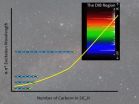(Press-News.org) WASHINGTON D.C., July 29, 2014 – Over the vast, empty reaches of interstellar space, countless small molecules tumble quietly though the cold vacuum. Forged in the fusion furnaces of ancient stars and ejected into space when those stars exploded, these lonely molecules account for a significant amount of all the carbon, hydrogen, silicon and other atoms in the universe. In fact, some 20 percent of all the carbon in the universe is thought to exist as some form of interstellar molecule.
Many astronomers hypothesize that these interstellar molecules are also responsible for an observed phenomenon on Earth known as the "diffuse interstellar bands," spectrographic proof that something out there in the universe is absorbing certain distinct colors of light from stars before it reaches the Earth. But since we don't know the exact chemical composition and atomic arrangements of these mysterious molecules, it remains unproven whether they are, in fact, responsible for the diffuse interstellar bands.
Now in a paper appearing this week in The Journal of Chemical Physics, from AIP Publishing, a group of scientists led by researchers at the Harvard-Smithsonian Center for Astrophysics in Cambridge, Mass. has offered a tantalizing new possibility: these mysterious molecules may be silicon-capped hydrocarbons like SiC3H, SiC4H and SiC5H, and they present data and theoretical arguments to back that hypothesis.
At the same time, the group cautions that history has shown that while many possibilities have been proposed as the source of diffuse interstellar bands, none has been proven definitively.
"There have been a number of explanations over the years, and they cover the gamut," said Michael McCarthy a senior physicist at the Harvard-Smithsonian Center for Astrophysics who led the study.
Molecules in Space and How We Know They're There
Astronomers have long known that interstellar molecules containing carbon atoms exist and that by their nature they will absorb light shining on them from stars and other luminous bodies. Because of this, a number of scientists have previously proposed that some type of interstellar molecules are the source of diffuse interstellar bands -- the hundreds of dark absorption lines seen in color spectrograms taken from Earth.
In showing nothing, these dark bands reveal everything. The missing colors correspond to photons of given wavelengths that were absorbed as they travelled through the vast reaches of space before reaching us. More than that, if these photons were filtered by falling on space-based molecules, the wavelengths reveal the exact energies it took to excite the electronic structures of those absorbing molecules in a defined way.
Armed with that information, scientists here on Earth should be able to use spectroscopy to identify those interstellar molecules -- by demonstrating which molecules in the laboratory have the same absorptive "fingerprints." But despite decades of effort, the identity of the molecules that account for the diffuse interstellar bands remains a mystery. Nobody has been able to reproduce the exact same absorption spectra in laboratories here on Earth.
"Not a single one has been definitively assigned to a specific molecule," said Neil Reilly, a former postdoctoral fellow at Harvard-Smithsonian Center for Astrophysics and a co-author of the new paper.
Now Reilly, McCarthy and their colleagues are pointing to an unusual set of molecules — silicon-terminated carbon chain radicals — as a possible source of these mysterious bands.
As they report in their new paper, the team first created silicon-containing carbon chains SiC3H, SiC4H and SiC5H in the laboratory using a jet-cooled silane-acetylene discharge. They then analyzed their spectra and carried out theoretical calculations to predict that longer chains in this family might account for some portion of the diffuse interstellar bands.
However, McCarthy cautioned that the work has not yet revealed the smoking gun source of the diffuse interstellar bands. In order to prove that these larger silicon capped hydrocarbon molecules are such a source, more work needs to be done in the laboratory to define the exact types of transitions these molecules undergo, and these would have to be directly related to astronomical observations. But the study provides a tantalizing possibility for finding the elusive source of some of the mystery absorption bands -- and it reveals more of the rich molecular diversity of space.
"The interstellar medium is a fascinating environment," McCarthy said. "Many of the things that are quite abundant there are really unknown on Earth."
INFORMATION:
The article, "Optical Spectra of the Silicon-Terminated Carbon Chain Radicals SiCnH (n=3,4,5)," is authored by D. L. Kokkin, N. J. Reilly, R. C. Fortenberry, T. D. Crawford and M. C. McCarthy. It will be published in The Journal of Chemical Physics on July 29, 2014. After that date, it can be accessed at: http://scitation.aip.org/content/aip/journal/jcp/141/4/10.1063/1.4883521
Authors of the paper are affiliated with Harvard University, Arizona State University, Virginia Tech, the University of Louisville and Georgia Southern University.
ABOUT THE JOURNAL
The Journal of Chemical Physics publishes concise and definitive reports of significant research in the methods and applications of chemical physics. See: http://jcp.aip.org
Mysterious molecules in space
Researchers at Harvard-Smithsonian Center for Astrophysics finger silicon-capped hydrocarbons as possible source of mysterious 'diffuse interstellar bands'
2014-07-29
ELSE PRESS RELEASES FROM THIS DATE:
This week from AGU: Cell tower rain gauges, lightning channels, North Sea storm surge
2014-07-29
This Week From AGU: Cell phone tower rain gauges, lightning channels, North Sea storm surge
From AGU's blogs: Dropped cell phone calls become rain gauges in West Africa
A shaky cell phone connection during a rainstorm can be an annoying nuisance. But now scientists are showing that these weakened signals can be used to monitor rainfall in West Africa, a technique that could help cities in the region better prepare for floods and combat weather-related diseases, according to a new study accepted for publication in Geophysical Research Letters, a journal of the American ...
Penn team makes cancer glow to improve surgical outcomes
2014-07-29
The best way to cure most cases of cancer is to surgically remove the tumor. The Achilles heel of this approach, however, is that the surgeon may fail to extract the entire tumor, leading to a local recurrence.
With a new technique, researchers at the University of Pennsylvania have established a new strategy to help surgeons see the entire tumor in the patient, increasing the likelihood of a positive outcome. This approach relies on an injectable dye that accumulates in cancerous tissues much more so than normal tissues. When the surgeon shines an infrared light on the ...
Huge waves measured for first time in Arctic Ocean
2014-07-29
As the climate warms and sea ice retreats, the North is changing. An ice-covered expanse now has a season of increasingly open water which is predicted to extend across the whole Arctic Ocean before the middle of this century. Storms thus have the potential to create Arctic swell – huge waves that could add a new and unpredictable element to the region.
A University of Washington researcher made the first study of waves in the middle of the Arctic Ocean, and detected house-sized waves during a September 2012 storm. The results were recently published in Geophysical Research ...
Underwater elephants
2014-07-29
In the high-tech world of science, researchers sometimes need to get back to basics. UC Santa Barbara's Douglas McCauley did just that to study the impacts of the bumphead parrotfish (Bolbometopon muricatum) on coral reef ecosystems at two remote locations in the central Pacific Ocean.
Using direct observation, animal tracking and computer simulation, McCauley, an assistant professor in the Department of Ecology, Evolution and Marine Biology, and his colleagues sought to understand whether the world's largest parrotfish is necessary for positively shaping the structure ...
Vision-correcting display makes reading glasses so yesterday
2014-07-29
BERKELEY — What if computer screens had glasses instead of the people staring at the monitors? That concept is not too far afield from technology being developed by computer and vision scientists at the University of California, Berkeley.
The researchers are developing computer algorithms to compensate for an individual's visual impairment, and creating vision-correcting displays that enable users to see text and images clearly without wearing eyeglasses or contact lenses. The technology could potentially help hundreds of millions of people who currently need corrective ...
Researchers take steps toward development of a vaccine against tick-transmitted disease
2014-07-29
Virginia Commonwealth University School of Medicine researchers have made an important advancement toward developing a vaccine against the debilitating and potentially deadly tick-transmitted disease, human granulocytic anaplasmosis (HGA).
During the past several years, experts have seen a steady rise in the incidence of human infections caused by tick-transmitted bacterial pathogens — making the need for a vaccine critical. Successful vaccine development hinges on knowing what to target to prevent disease, and the VCU team has identified three such proteins on the surface ...
Brainwaves can predict audience reaction for television programming
2014-07-29
Media and marketing experts have long sought a reliable method of forecasting responses from the general population to future products and messages. According to a study conducted at the City College of New York (CCNY) in partnership with Georgia Tech, it appears that the brain responses of just a few individuals are a remarkably strong predictor.
By analyzing the brainwaves of 16 individuals as they watched mainstream television content, researchers were able to accurately predict the preferences of large TV audiences, up to 90 percent in the case of Super Bowl commercials. ...
Socialization relative strength in fragile X longitudinal study
2014-07-29
Standard scores measuring "adaptive behavior" in boys with fragile X syndrome tend to decline during childhood and adolescence, the largest longitudinal study of the inherited disorder to date has found.
Adaptive behavior covers a range of everyday social and practical skills, including communication, socialization, and completing tasks of daily living such as getting dressed. In this study, socialization emerged as a relative strength in boys with fragile X, in that it did not decline as much as the other two domains of adaptive behavior measured: communication and daily ...
Brand-specific television alcohol ads predict brand consumption among underage youth
2014-07-29
Underage drinkers are three times more likely to drink alcohol brands that advertise on television programs they watch compared to other alcohol brands, providing new and compelling evidence of a strong association between alcohol advertising and youth drinking behavior.
This is the conclusion of a new study from the Center on Alcohol Marketing and Youth (CAMY) at the Johns Hopkins Bloomberg School of Public Health and the Boston University School of Public Health that examined whether exposure to brand-specific alcohol advertising on 20 television shows popular with ...
$15 billion annual public funding system for doctor training needs overhaul, says IOM
2014-07-29
WASHINGTON -- The U.S. should significantly reform the federal system for financing physician training and residency programs to ensure that the public's $15 billion annual investment is producing the doctors that the nation needs, says a new report by the Institute of Medicine. Current financing -- provided largely through Medicare -- requires little accountability, allocates funds independent of workforce needs or educational outcomes, and offers insufficient opportunities to train physicians in the health care settings used by most Americans, the report says.
All ...
LAST 30 PRESS RELEASES:
Empty-handed neurons might cause neurodegenerative diseases
Black women hospitalised in USA with blood infection resistant to last-resort antibiotic at increased risk of death
NEC Society Statement on the Watson vs. Mead Johnson Verdict
Lemur’s lament: When one vulnerable species stalks another
Surf clams off the coast of Virginia reappear – and rebound
Studying optimization for neuromorphic imaging and digital twins
ORNL researchers win Best Paper award for nickel-based alloy tailoring
New beta-decay measurements in mirror nuclei pin down the weak nuclear force
Study uncovers neural mechanisms underlying foraging behavior in freely moving animals
Gene therapy is halting cancer. Can it work against brain tumors?
New copper-catalyzed C-H activation strategy from Scripps Research
New compound from blessed thistle promotes functional nerve regeneration
Auburn’s McCrary Institute, ORNL to partner on first regional cybersecurity center to protect the nation’s electricity grid
New UNC-Chapel Hill study examines the increased adoption of they/them pronouns
Groundbreaking study reveals potential diagnostic marker for multiple sclerosis years before symptom onset
Annals of Internal Medicine presents breaking scientific news at ACP’s Internal Medicine Meeting 2024
Scientists discover new way to extract cosmological information from galaxy surveys
Shoe technology reduces risk of diabetic foot ulcers
URI-led team finds direct evidence of ‘itinerant breeding’ in East Coast shorebird species
Wayne State researcher aims to improve coding peer review practices
Researchers develop a new way to safely boost immune cells to fight cancer
Compact quantum light processing
Toxic chemicals from microplastics can be absorbed through skin
New research defines specific genomic changes associated with the transmissibility of the monkeypox virus
Registration of biological pest control products exceeds that of agrochemicals in Brazil
How reflecting on gratitude received from family can make you a better leader
Wearable technology assesses surgeons’ posture during surgery
AATS and CRF® partner on New York Valves: The structural heart summit
Postpartum breast cancer and survival in women with germline BRCA pathogenic variants
Self-administered acupressure for probable knee osteoarthritis in middle-aged and older adults
[Press-News.org] Mysterious molecules in spaceResearchers at Harvard-Smithsonian Center for Astrophysics finger silicon-capped hydrocarbons as possible source of mysterious 'diffuse interstellar bands'



